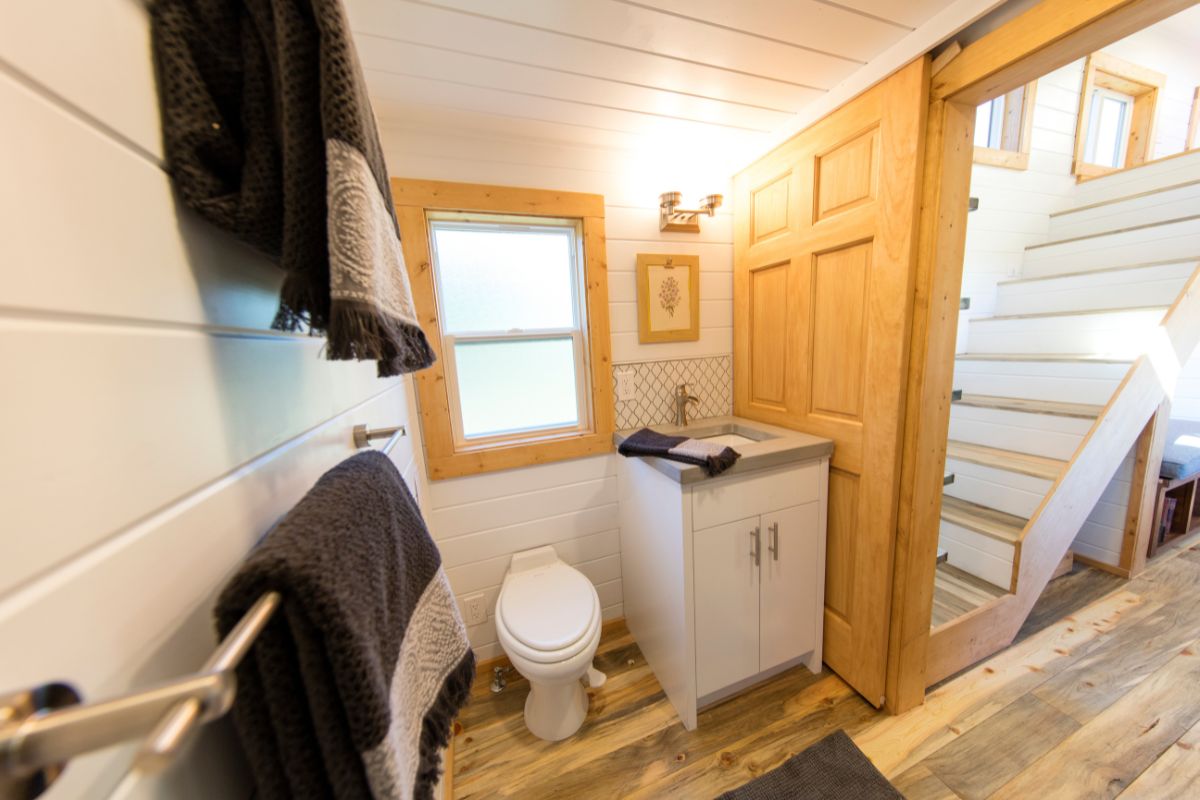Eco-Friendly Building Materials
Reclaimed wood and recycled metal are top choices for an eco-friendly tiny home. These materials reduce waste and add unique character to your space, making each piece in your home one-of-a-kind. Using reclaimed materials conserves resources and incorporates history and craftsmanship into your design.
Locally sourced materials further minimize transportation emissions, reducing your carbon footprint. They also support the local economy, making your build not just sustainable but community-focused. Natural options like bamboo and cork are both renewable and durable, ideal for flooring and insulation. Bamboo, for example, grows quickly and requires fewer resources to produce, while cork offers excellent thermal insulation.
These materials promote a healthier indoor environment, free from harmful chemicals, ensuring your tiny home is sustainable and safe.
Sustainable Outdoor Spaces
Maximizing outdoor space is essential for enhancing the livability of a tiny home. A well-planned outdoor area can extend your living space and offer opportunities for sustainable practices. Consider creating a small garden or patio where you can relax, entertain, or even grow your own food. Raised garden beds or vertical gardens are particularly effective in small spaces, allowing you to grow herbs, vegetables, or flowers without taking up much room.
.png)
Choosing sustainable materials for your outdoor furniture and structures is also important. Opt for recycled or reclaimed materials, which reduce waste and add unique character to your outdoor area.
For those with artificial turf, maintaining it with environmentally friendly products is crucial. Using artificial turf cleaning products that are non-toxic and biodegradable ensures that your outdoor space remains eco-friendly and safe for both your family and the environment.
Energy Efficiency
Maximizing energy efficiency in a tiny home starts with proper insulation. Quality insulation keeps your home warm in winter and cool in summer, cutting down on the need for excessive heating or cooling. This reduces both energy consumption and utility costs.
Solar panels are a smart addition, allowing you to generate your own electricity. When paired with energy-efficient appliances, you can significantly lower your overall power usage.
Switching to LED lighting further enhances energy efficiency. LEDs consume less power and have a longer lifespan than traditional bulbs. Another effective strategy is installing energy-efficient windows. Double-glazed windows, for example, provide better insulation, reducing heat loss in winter and keeping your home cooler in summer.
Water Conservation
Water conservation is crucial in tiny homes, where space and resources are limited. Installing a rainwater harvesting system is a practical solution. These systems collect rainwater from your roof and store it for later use, such as watering plants or flushing toilets. This reduces dependence on municipal water supplies and helps lower your water bills.
Low-flow fixtures are another essential component. Low-flow faucets and showerheads significantly reduce water usage without compromising performance. These fixtures decrease the amount of water that needs to be heated, which in turn reduces energy consumption.
Composting toilets offer a sustainable waste management option that also conserves water. Unlike traditional toilets, they require little to no water to operate, turning waste into usable compost.
Greywater recycling is another effective method to conserve water in a tiny home. This system captures water from sinks, showers, and washing machines, treating it for reuse in irrigation or toilet flushing. By recycling greywater, you can further reduce your reliance on fresh water sources and make your tiny home even more eco-friendly. Integrating these water-saving strategies not only supports sustainable living but also enhances the overall efficiency and self-sufficiency of your tiny home.
Maximizing Indoor Air Quality
Maintaining good indoor air quality is crucial in a small space like a tiny home. Start by using natural, non-toxic materials for walls, flooring, and insulation. These materials emit fewer volatile organic compounds (VOCs), which can significantly improve air quality.
Proper ventilation is key. Installing energy-efficient windows that open easily helps circulate fresh air and remove indoor pollutants. Adding a small energy-recovery ventilator (ERV) or heat-recovery ventilator (HRV) can further improve air exchange while maintaining energy efficiency.
Indoor plants can contribute to better air quality, though their effect is modest. While some studies suggest that certain plants can remove toxins, their impact is limited in real-world conditions. Plants should be seen as a supplemental measure, alongside proper ventilation and air purification systems.
Minimizing Waste
Living in a tiny home naturally encourages a minimalist lifestyle, which aligns well with waste reduction. However, it’s important to be intentional about minimizing waste in all aspects of tiny living. Start by adopting a zero-waste mindset, focusing on reducing, reusing, and recycling wherever possible.
Composting is a practical solution for organic waste. If your tiny home has a garden, a small composting system can turn kitchen scraps into valuable fertilizer for your plants. Doing so reduces the waste you send to landfills and provides nutrient-rich soil for your garden.
.png)
Another effective strategy is to be mindful of your purchases. Opt for products with minimal packaging, and choose reusable items over single-use alternatives. For example, use cloth napkins instead of paper ones, and invest in durable, long-lasting kitchenware.
Consider implementing water-saving techniques to further reduce your environmental footprint. Install low-flow faucets and showerheads, and collect rainwater for gardening or other non-potable uses. By being conscious of your water consumption, you can significantly cut down on waste and make your tiny home even more sustainable.
Wrapping Up
Embracing green living in a tiny home is more than a trend. It’s a commitment to sustainability and mindful living. Your tiny home becomes a haven of efficiency and eco-friendliness by making intentional choices in materials, energy use, and waste reduction. Every step contributes to a healthier environment and a more fulfilling way of life.






Share: